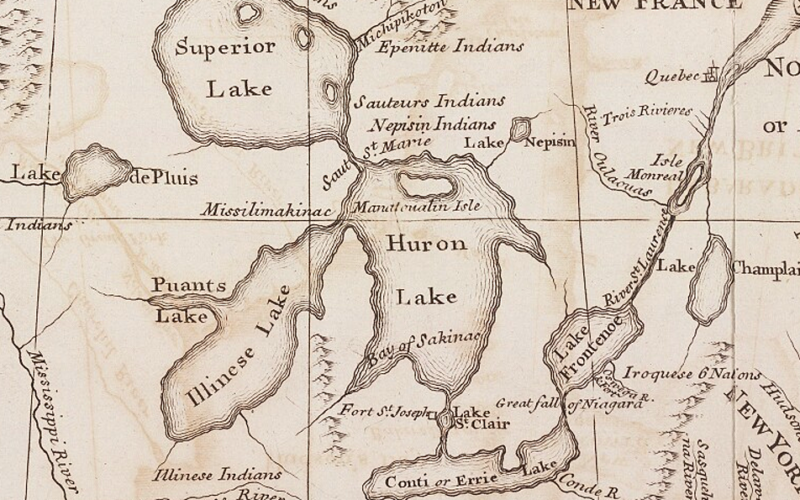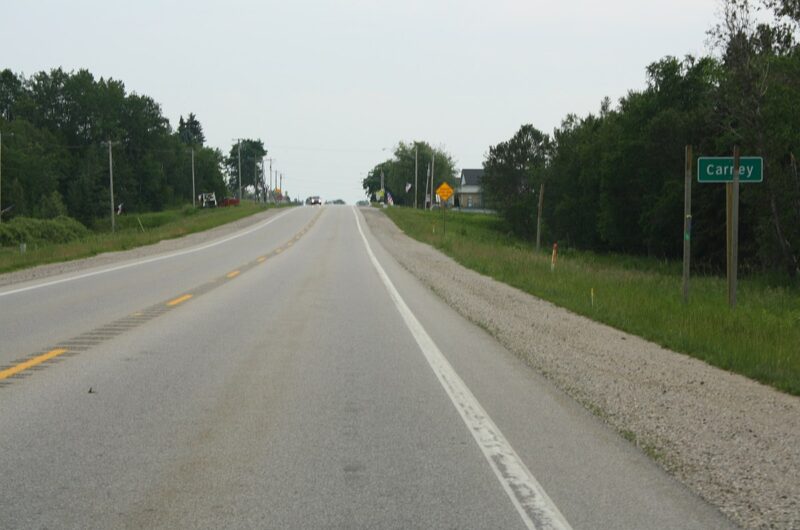The French Regime in the Upper Peninsula – Part Two

“Rural Voices” shares cultural, educational, economic and artistic views of people who have lived and thrived in the Upper Peninsula. Each of our authors in Rural Voices may be living here in the U.P. or living someplace around the globe, but the U.P. is an important part of who they are and what their beliefs and values are today. Rural Voices wants to share the voices of our neighbors and friends about life and experiences in the UP.
PART 2
French Claim the Upper Lakes
In the meantime, the French officials decided to claim all of the upper lakes country for the French king, Louis XIV. In 1671, François Daumont, Sieur de St. Lusson was ordered to take a contingent of troops with their best uniforms and regalia and go to Sault Ste. Marie.
French emissaries were sent among the Indians to invite tribal representatives to witness the grand event planned for June 4-14 at Sault Ste. Marie. Sieur de St. Lusson orchestrated the event, which included the raising of a cross with the French royal standard as the troops lined up in smart attention, with Jesuits on hand to add to the ceremony. On a hill overlooking the St. Mary’s River, the land was claimed for the French king as the soldiers shouted, “Long live the king” and fired their muskets.
Father Allouez gave a strong Indian-style oration telling everyone present of the power France and alluding to the disastrous consequences if their alliance was broken. The French were in the Upper Peninsula to stay.
Settlement of St. Ignace
The year 1671 was important in the history of the Upper Peninsula for a number of reasons. Besides the claiming ceremony, the Hurons and Odawas moved to the Straits area and began a settlement that would make this waterway the “entrepôt of the north.”
Despite talk of settling on Mackinac Island, there was general agreement to settle on the mainland, which afforded more land for the large Indian population and where winter travel would not be impeded by ice. The new community located on the shores of East Moran Bay consisted of the Indian villages, the Jesuit mission, and a fur trading center.
The two Native communities were the Odawa and the Huron, who lived in two separate fortified villages protected by palisades. The Odawa consisted of four distinct groups: the Kiskakons (Cut Tails), the most numerous; the Sable, named after the sandy soil of their former homes; the Sinago or Black Squirrels; and the Nassauekueton (Fork), probably named after their chief, LaFourche.
These Odawa groups were on good terms with one another and lived in harmony. A smaller group of Odawa was located two miles to the west at the mission of St. Francis Borgia, established in 1677. The Hurons differed from the Odawa in speaking the Iroquoian language. Furthermore, they were mostly Christian, and this bothered the Odawa, who saw them as “less Indian” because of their acceptance of the French culture and religion.
And the earlier wars with the Iroquois had greatly reduced the Hurons’ numbers, further weakening them relative to the nearby Odawa.
The Indians practiced a number of occupations. The Odawa, known as traders among their Indian brethren and living in proximity to French traders, continued to play an important trade role. Indians from distant lands came to St. Ignace to trade. All of the Indians including the Odawa trapped beaver and other fur-bearing animals and exchanged these pelts for guns, powder, bullets tobacco “and everything in use” among the French.
Given the northern latitude of the Upper Peninsula, agriculture is often ignored as an economic activity, but French had brought farming and gardening to New France, especially at Montréal and Québec City where habitants, the Jesuits and the religious had extensive gardens and farms. It was a simple operation to transfer vegetable seeds and fruit pits and possibly even tree cuttings to the interior settlements.
Both the Huron and the Odawa planted and harvested an abundant supply of Indian corn, beans, pumpkins and watermelons. The French provided the Huron and Odawa with peas, potatoes, and fruit trees—apple, pear, cherry, plum—all of which greatly enhanced the lives of these people by giving them a more varied and consistent food supply. The fruit could be dried for winter use and used to make cider.
The great abundance of fish in the Straits of Mackinac had always lured Indians to the area. As Governor Cadillac wrote: “It is a daily manna which never fails. There is no family which does not catch sufficient fish in the course of the year for its subsistence.”
The French raved about the quality of whitefish, trout, sturgeon, pike, herring and “a hundred different kinds of fish” in the clear blue waters. The Indians ate fish in a variety of ways: in a special corn mush, roasted, smoked, boiled and stewed. They also used elk grease, and buffalo grease imported from the Illinois Indians, to flavor their food.
Three years after Father Marquette had established the mission at Sault Ste. Marie in 1668, he returned some fifty miles south to establish his second mission in the Upper Peninsula. He dedicated the mission to St. Ignatius of Loyola, the founder of the Jesuit order, and the French spelling “St. Ignace” has been used ever since.
The Jesuit complex was located about a mile south of the Native American villages and consisted of a chapel, residence and meeting place. After the permanent church was completed in 1674, during the dedication ceremonies the missionaries gave sermons in three languages–French, Huron, and Odawa. This use of multi-languages in churches services would continue as part of Upper Peninsula religious exercises well into the early twentieth century—with the coming of the immigrants.
On the second anniversary of Father Marquette’s death–May 19, 1677–the Kiskakon Odawa returning from their winter hunt located Marquette’s grave in western lower Michigan and disinterred the body. In an act of great respect to the missionary’s memory, the Native Americans carefully placed the remains in a birch bark box.
The funeral procession, consisting of thirty canoes paddled by Odawa and a few Iroquois, returned to St. Ignace. After lying in state for a day, the remains were buried in a small vault in the middle of the church on June 9th. After this event, many Native Americans visited the tomb for prayer. During the Christmas season in 1682, the church and its counterpart, that of St. Francis Borgia, were the sites of religious ceremonies where statues were exchanged.
The small Odawa population to the west of St. Ignace had developed into a mission site. In 1677 Jesuits Henri Nouvel and Jean Enjalrau began construction of the church of St. Francis Borgia, another sainted Jesuit. For a time this mission was the headquarters for the entire mission operation at the Straits and extended down into Green Bay.
A third complex was established in 1681 and called Fort Buade, using the family name of Governor Frontenac. The fortified settlement was based on a European town pattern with some sixty log cabins with planked roofs covered with cedar bark. By 1695, there were approximately two hundred well-disciplined troops at the post along with fur traders.
This larger Straits community now consisted of a variety of people. There were the two main Native American tribes: the Huron and the Odawa. But there were also visiting tribesmen there for trading or fishing, and many Native people who had married into the community and served as slaves (called panis), servants, and laborers.
There were also a small number of African freemen and slaves living there as well. An important component of the community was the métis, or mixed-blood, population, composed of the children of Native and French inter-marriage. A rich multi-ethnic community had developed in the Mid-Continent.
Not all was peaceful and tranquil in these communities, where issues and tensions developed over trade and social rivalries. About this time the first public execution in Michigan took place after some Indians from the Keweenaw Bay area murdered two Frenchmen. Sieur Du’Lhut captured them and brought them to St. Ignace where a trial was held and the Indians found guilty and executed—by Native Americans.
By the late 1670s the fur trade assumed the dominant economic role in the affairs of the Straits of Mackinac. Since Montréal became the “gateway to the West” its merchants dominated the trade. As the years passed, Mackinac became the stepping stone to interior trade.
If the social and commercial affairs of the Upper Peninsula were on people’s minds, so was the question of introducing sailing vessels into the Great Lakes. As René-Robert de La Salle created plans to develop the fur trade, he decided that Indian canoes were not large enough to move the large quantities of furs and goods that he planned to ship into and out of the Great Lakes.
So in 1679, he had the Griffon constructed above the falls at Niagara and sailed it to Green Bay. On its return voyage, without La Salle, the ship sank in a vicious September storm in the vicinity of the Straits of Mackinac. After that tragic event the French fell back on canoes as their primary mode of transportation on the Lakes.
During the closing years of the 17th century, the history of the Upper Peninsula was marked by continuous alliances to counter the hostility from the various tribes in the west. The Iroquois, never the allies of the French, were constantly working to ally themselves with the Odawa and other Great Lakes tribes. The Native history of this period is very complicated and intertwined with these alliances.
The French had to use their best ability to implement “forest diplomacy” and maintain their Indian alliances and the fur trade. The English, operating out of Albany, New York, and allies of the Iroquois, played a major role in this struggle.
In 1678, Daniel Greysolon Sieur Du’Lhut reported that the Odawa, led by Kinongé, had plundered fur convoys on Lake Superior. He feared that the victimized Cree would abandon the French and shift their trade north to the English on Hudson Bay. When the Cree threatened revenge, Kinongé decided to trade near the Illinois Country to the south. Du’Lhut worked diligently to broker peace with the Odawa, Lakota, Cree and Monsoni and keep them from trading with the English.
Antoine Laumet de La Mothe Sieur de Cadillac was appointed commandant of Fort Buade in 1694. When he arrived in the autumn he found the fort in disrepair and the morale of the troops low. During King Williams’ War (1695-1697) Cadilllac’s duties at Fort Buade were threefold: 1) keep all of the western tribes in the French alliance, 2) make them live in harmony with each other, and 3) induce them to wage war on the Iroquois.
Despite these mandates, English traders, entering Michigan and the Mackinac area through d’ étroits (“the narrows”—what became Detroit) continued to intrude on French territory and trade with the Indians. Cadillac prospered as a fur trader, making his profits through the sale of brandy and by fleecing coureurs-de-bois. The brandy trade was attacked by the Jesuits and especially by Father Étienne Carheil at St. Ignace, who provoked the enmity of Cadillac and the fur traders. In 1702 Carheil was still attacking the brandy trade and also condemning the fur traders for keeping Native girls and women as servants, wood cutters and cooks, who he said were merely prostitutes.
In the 1690’s, the global demand for fur declined and prices dropped. King Louis XIV ordered the trading at the Straits curtailed and the site abandoned. In response to this action, Commandant Cadillac developed a multi-faceted concept. Since the English were entering French territory and ultimately meddling with the trade at the Straits, why not developed a new post at The Narrows—Detroit.
This would allow Cadillac to halt English and Iroquois incursions and provide himself with a post where he could monopolize the fur trade. In July 1701 Fort Pontchartrain d’ Étroit was established. Very quickly Cadillac, who disliked the Jesuits and wanted to destroy their missionary work, induced the Hurons to move to Detroit, where they established a large village at the mouth of the Huron River. Some of the Odawa were encouraged to migrate southward although most stayed in the Straits area.
During the following years there was an on-going struggle to induce the Jesuits and the Odawa to leave their homes at the Straits and move to Detroit. Nonetheless, the fur trade at Mackinac prospered and outstripped that of Detroit, although Detroit was considered the new trade center in the Great Lakes country, in 1708 only 700 pounds of beaver pelts were sent to Montréal while over 40,000 pounds of pelts were sent from the Straits of Mackinac.
Creation of Fort Michilimackinac
The next phase in the history of the Straits of Mackinac began in 1712. At this time the French realized that their closure of Fort Buade had led to the decline of the fur trade by driving the Indians into English hands at Hudson Bay and eastward toward Albany.
Then due to a misunderstanding and Indian hostility, a group of Fox Indians from Wisconsin who had been invited to settle near Detroit were attacked. This began the lengthy and bloody Fox Wars. In an effort to take the war to the Fox villages in Wisconsin, the French decided to open a new fort on the south side of the Straits called Fort Michilimackinac. This fort was opened in 1715 and became the new center of the upper lakes fur trade, which developed into a large and powerful establishment.
War did not stop with the Fox Indians. The Ojibwe began their movement westward and encountered the Dakota. Better equipped because of their trade with the French, the Ojibwe eventually dominated the Dakota and by the 1830’s drove them into southern Minnesota. Other local skirmishes developed between many of the local Indians of the Upper Peninsula but usually ended through French mediation. During the various wars between the French and British that began in 1689 and ended in 1763 the local Indians joined the French and their military allies.
Métis Population
During this period a new element of the population emerged, as envisioned by Champlain, at locations like Sault Ste. Marie and Mackinac—the Métis or mixed blood people. The products of Indian-French unions, these people tended to absorb the best of both worlds. Resistant to diseases that devastated the full-blooded Indians, they followed the Indian economic patterns and also farmed, primarily growing peas and potatoes.
They had large families and many of them played important roles not only during the colonial period but during the early American period as well. Two of the more prominent families were the Langlades and the Cadottes. Augustin Mouet de Langlade (1703-1777) settled at Mackinac, became a prominent trader and married an Odawa woman, Domitilde Oukabe dit Neveu La Foruche (1707-1754), daughter of the prominent Odawa chief, La Fourche or Nissowaquet.
Their son Charles (1729-1801) became a prominent citizen, fur trader and military leader, known for his influence with the Native Americans due to his relative, Chief Nissowaquet. By 1750, Langlade was a cadet in the French Colonial Regulars and in the following years he proved to be an able solider and military leader in actions against the English and their Indian allies. Praised by the French governor for his bravery, he easily made the transition from the French to the English regimes in 1763 and settled in Green Bay. During the American Revolution he joined with the British forces.
The other prominent métis family was that of Jean-Baptiste Cadotte (1723-c1803+) of Sault Ste. Marie. His two sons, Jean Baptiste, Junior (b-1761) and Michel (1762-1807), were engaged as prominent fur entrepreneurs, interpreters (fluent in Ojibwe, French and English), and guides by the British and then the Americans.
They played an important role in maintaining good relations among the Native Americans, British and Americans. As a matter of fact, the Cadottes kept the Lake Superior Ojibwe out of Tecumseh’s influence during the War of 1812.
Indian Slavery
A little known aspect of American colonial history was the enslavement and trade of Indians by the French, British and Spanish colonists. During the French regime, the Great Lakes region played an important role in the development of the Indian slave trade, which centered at Fort Michilimackinac.
Many of these slaves–although never in large numbers; between 1671 and 1701 only 87 appeared in New France–were from the Great Plains to the west. The word panis, because many of these slaves were Pawnee from Nebraska, became part of the French-Canadian lexicon for Indian slave. Slaves were a commodity of trade and the guns which were traded allowed other Indians to continue the capture of other Indians. The French Crown legalized Indian slavery in 1709, recognizing what had existed. The immediate result was to stimulate the slave trade.
The French post at the Straits of Mackinac became the temporary and sometimes permanent home for over 115 Indian slaves whose origins were as diverse as Quapaws from Arkansas, Apaches and Comanches from the western Plains, Pawnee from Nebraska, Dakota and Mandans from the Upper Plains–and even some unfriendly Assiniboine, Crees, and Ojibwe. Indian slaves were also kept by traders who settled at Sault Ste. Marie during these years.
These slaves were owned by the fort commanders, officers, soldiers, voyageurs, traders, and other civilians, as well as by missionaries. For instance, the Jesuit missionary at Ste. Anne’s church at Michilimackinac owned three Indians and one Black. One of the Indians, a seven year old boy Jean-François Regis, had been given to the missionary as a gift from Sieur de La Vérendrye when he safely returned from a trading trip in the western Lake Superior country.
The missionaries’ rationale for keeping these Indians was that they would be converted and civilized according to a French model and thus live “better” lives among the French than with their own people. According to the Treaty of Paris (1763), slaves were private property to be retained by the French should they wish to keep them.
Part 3 of our three-part series will be conclude here on Friday, March 12th!






My thanks to you sir. Michigan history I never knew!
Thank you for this history information. I’ve always been interested in Upper Michigan. I visited the UP a few years ago and very muchly enjoyed the history.
My family is french from Canada. My great aunt told me My family decedent’s have spent time in Upper Michigan.
My mother’s family indian and English.
My friends are Finnish mostly from Upper Michigan.
I’m very interested in the history of Upper Michigan.
Thank you I enjoyed reading this and can’t wait to read more.
A great read.
I think you got the details of the Keweenaw Ojibwe murder trials wrong. A more detailed and interesting narrative can be found in books be Michael Witgen (Infinity of Nations) and Richard White (The Middle Ground).
Impressive!
Very interesting. Thank you!
Dr. Magnaghi deserves an award for the wonderful work he has done in documenting the history of the Upper Peninsula. I grew up here and was never taught this wonderful history of St Ignace and the intersecting cultures. Wonderful!!